VIEWS AND PERSPECTIVES
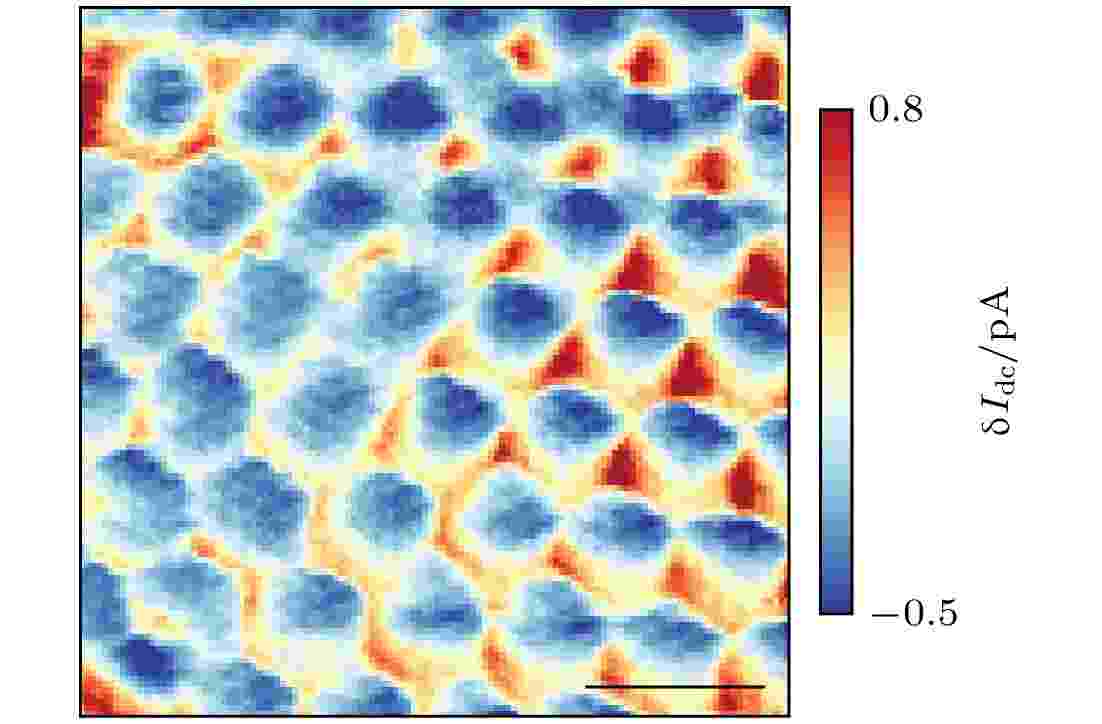
EDITOR'S SUGGESTION
2024, 73 (24): 240501.
doi: 10.7498/aps.73.20241039
Abstract +
In 1934, Eugene Wigner, who was studying at Princeton University, predicted the existence of electronic crystals. Electrons have both kinetic energy and potential energy of interaction. When the density of electronic states satisfies certain conditions, due to the repulsion between electrons, electrons will tend to arrange themselves in a regular lattice structure, forming electron crystals, which is also known as Wigner crystals. For nearly 90 years, Wigner crystals have fascinated condensed matter physicists. Physicists have designed many ingenious semiconductor heterojunctions to obtain lower electron densities and added magnetic fields to achieve larger effective mass of electron. In 1979, experiments revealed the existence of a phase transition from an electron liquid phase to an electron crystal on the surface of liquid helium, and subsequent experiments observed the characteristics of two-dimensional (2D) Wigner crystals in 2D electron gas under high magnetic fields. However, direct observation of 2D Wigner lattices in real space remains a formidable challenge. Through the graphene sensing layer of WSe2/WS2 moiré superlattice, Hongyuan Li, Feng Wang, et al. observed the real-space morphologies of Wigner crystals in their experiments. And in a recent study, researchers used high-resolution scanning tunneling microscopy to directly image magnetic field-induced Wigner crystals in Bernal stacking bilayer graphene and investigated their structural properties as a function of electron density, magnetic field, and temperature. In this paper, we will introduce some interesting things about Wigner crystals through four representative researches briefly.
INVITED REVIEW
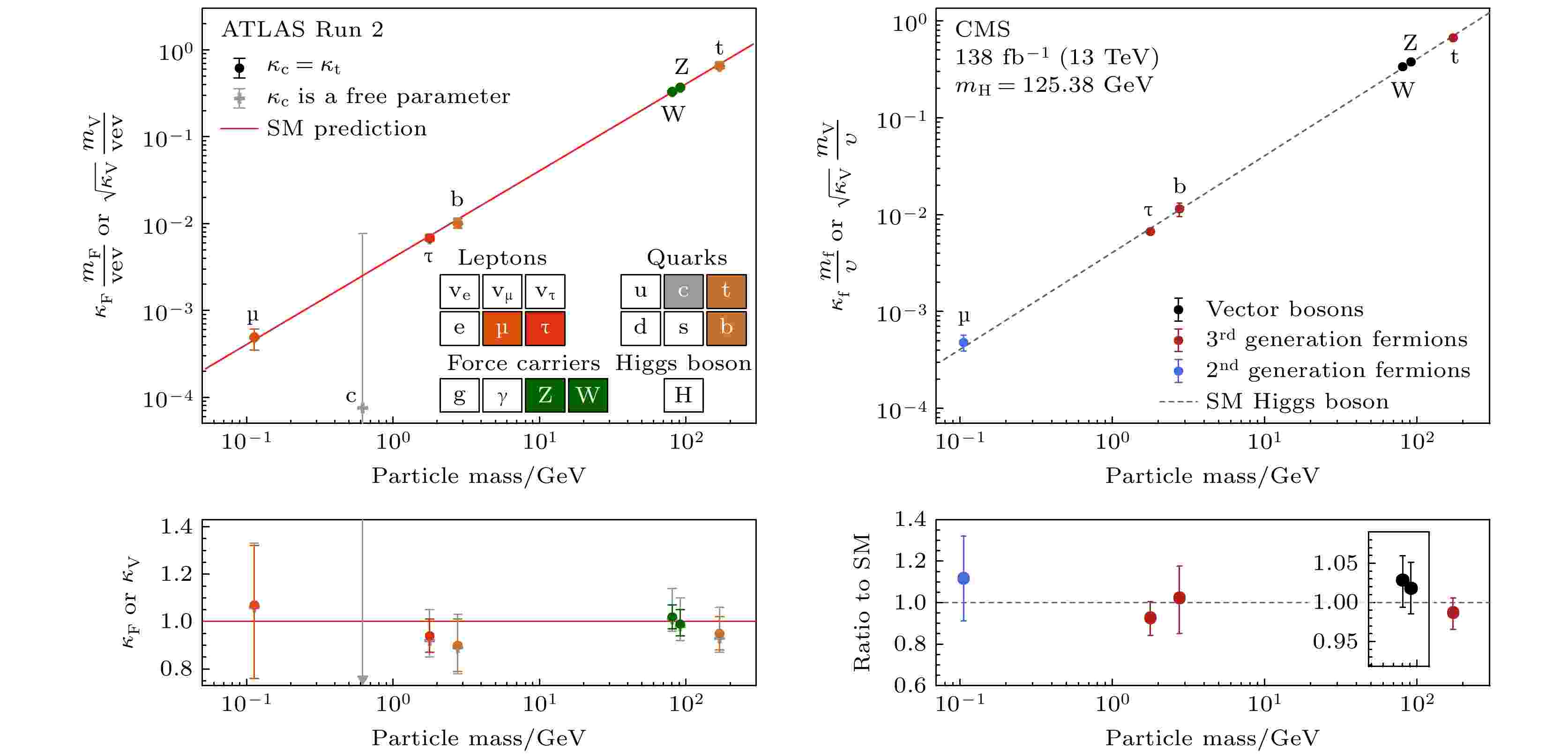
EDITOR'S SUGGESTION
2024, 73 (24): 241401.
doi: 10.7498/aps.73.20241207
Abstract +
This article reviews the discovery of the Higgs boson, discusses the studies of its properties, and introduces the physical prospects of the future Higgs factories. The greatest goal of particle physics is to understand the fundamental particles of the universe and how they interact with each other (or more generally, how the universe operates). In the standard model of particle phyiscs, the Higgs mechanism is proposed to explain the origin of elementary particle mass and predict the existence of the Higgs boson. Higgs physics is one of the most important research areas in particle physics. The Large Hadron Collider (LHC) at CERN (Geneva, Switzerland) accelerates proton beams to collide at center-of-mass energy of 13 TeV, thus defining the world’s energy frontier. The ATLAS and CMS detectors are two general-purpose detectors at the LHC for studying the debris from the collisions. The Higgs boson was discovered in the ATLAS and CMS experiments in 2012. This discovery completed the fundamental particle spectrum of the standard model and was an important milestone for particle physics. Since then, many studies have been conducted on the properties of Higgs boson, including spin, mass and couplings, to deepen our understanding of the Higgs mechanism. In particular, the Higgs boson couplings to fermions and to themselves present new kinds of fundamental interactions with paramount significance, which have not been fully confirmed. Additionally, the Higgs bosons has become an important tool to search for dark matter, heavy resonance, and other new physical phenomena. So far, there has been no deviation from the predictions of the standard model. Looking forward to the future, it is proposed to use the electron-positron collisions to study the Higgs boson in more depth. Physics studies have shown that these Higgs factories can significantly improve the accuracy of many properties of the Higgs boson, including width and couplings, and provide great physics prospects.
SPECIAL TOPIC—Dynamics of atoms and molecules at extremes

EDITOR'S SUGGESTION
2024, 73 (24): 244202.
doi: 10.7498/aps.73.20241456
Abstract +
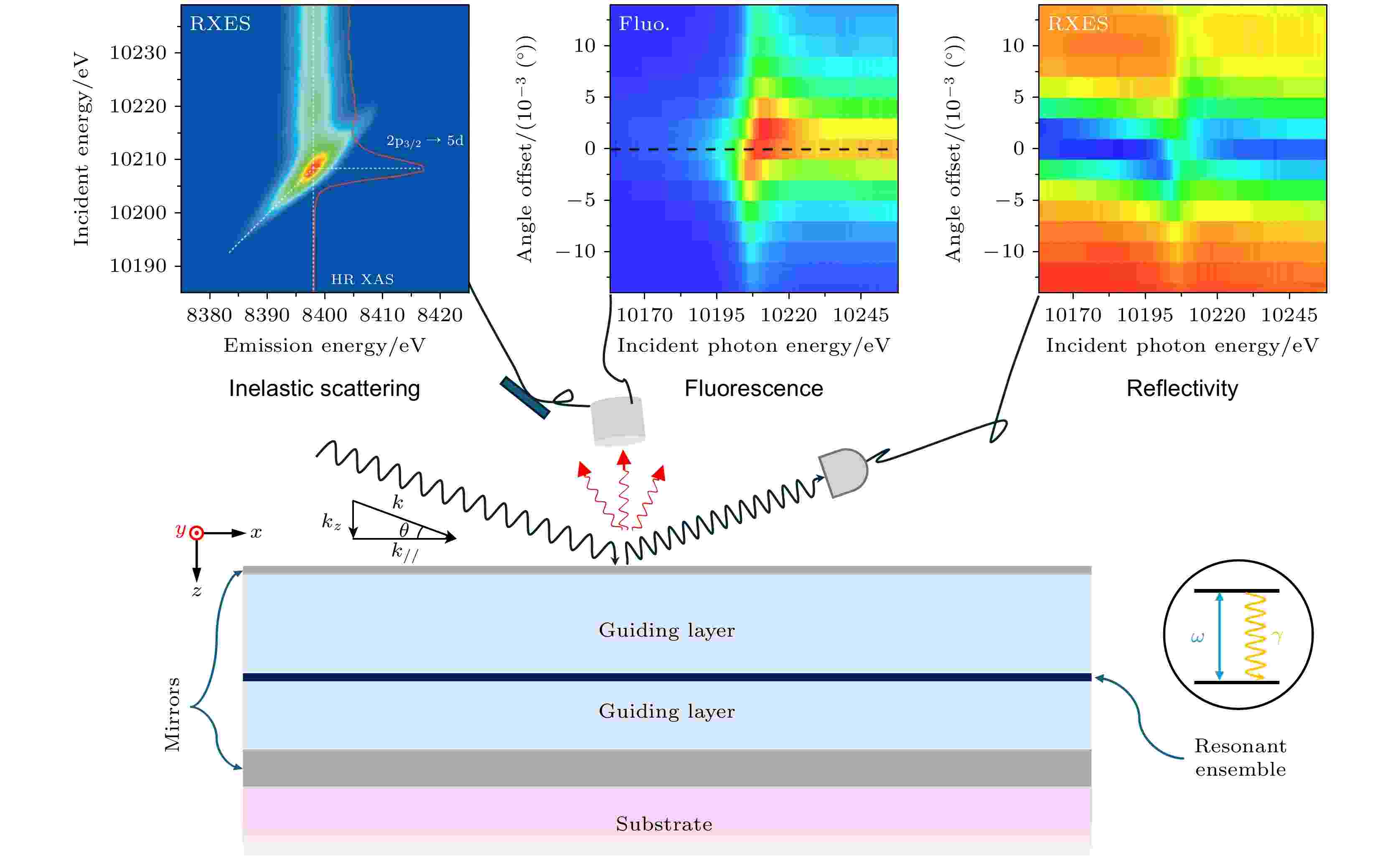
EDITOR'S SUGGESTION
2024, 73 (24): 246101.
doi: 10.7498/aps.73.20241218
Abstract +
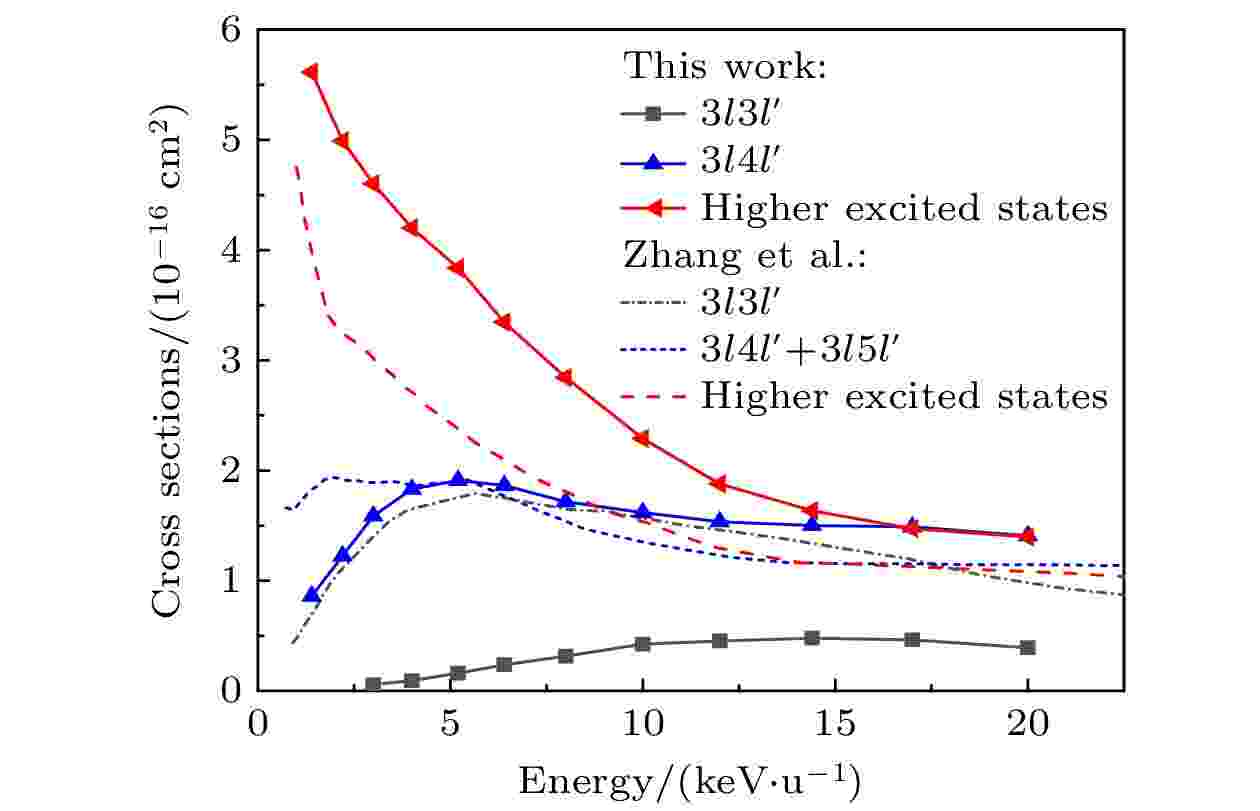
COVER ARTICLE
2024, 73 (24): 240701.
doi: 10.7498/aps.73.20241290
Abstract +
Electron capture in the collision of highly charged ions with atoms and molecules is a fundamental process related to the electron transition between bound states belonging to two atomic-centers. The X-ray emission after electron capture is important for X-ray astrophysical modeling, fusion plasma diagnostics, and ion irradiated biophysics. In the past few decades, momentum-imaging cold-target recoil ion momentum spectroscopy has been a significantly developed technique and widely used to measure the quantum state-selective population in electron capture processes. Based on the cold target recoil ion momentum spectroscopy installed on the 150 kV highly charged ion platform in Fudan University, Shanghai City, China, the state-selectivity of double electron capture in the bombardment of 1.4–20 keV/u Ar8+ on He is measured, and the relative cross sections of the 3l 3l' to 3l 7l' double excited states are obtained. It is found that with the increase of collision energy, more quantum state-selectivity channels are open in the double electron capture of Ar8+-He collision. It is also found that the relative cross section of the quantum state population is strongly dependent on the collision energy of the projectile ion. The present measurements not only enrich the state-selective cross-sectional library and collision dynamics of highly charged ion charge exchange processes, but also provide experimental benchmarks for existing theoretical calculations.
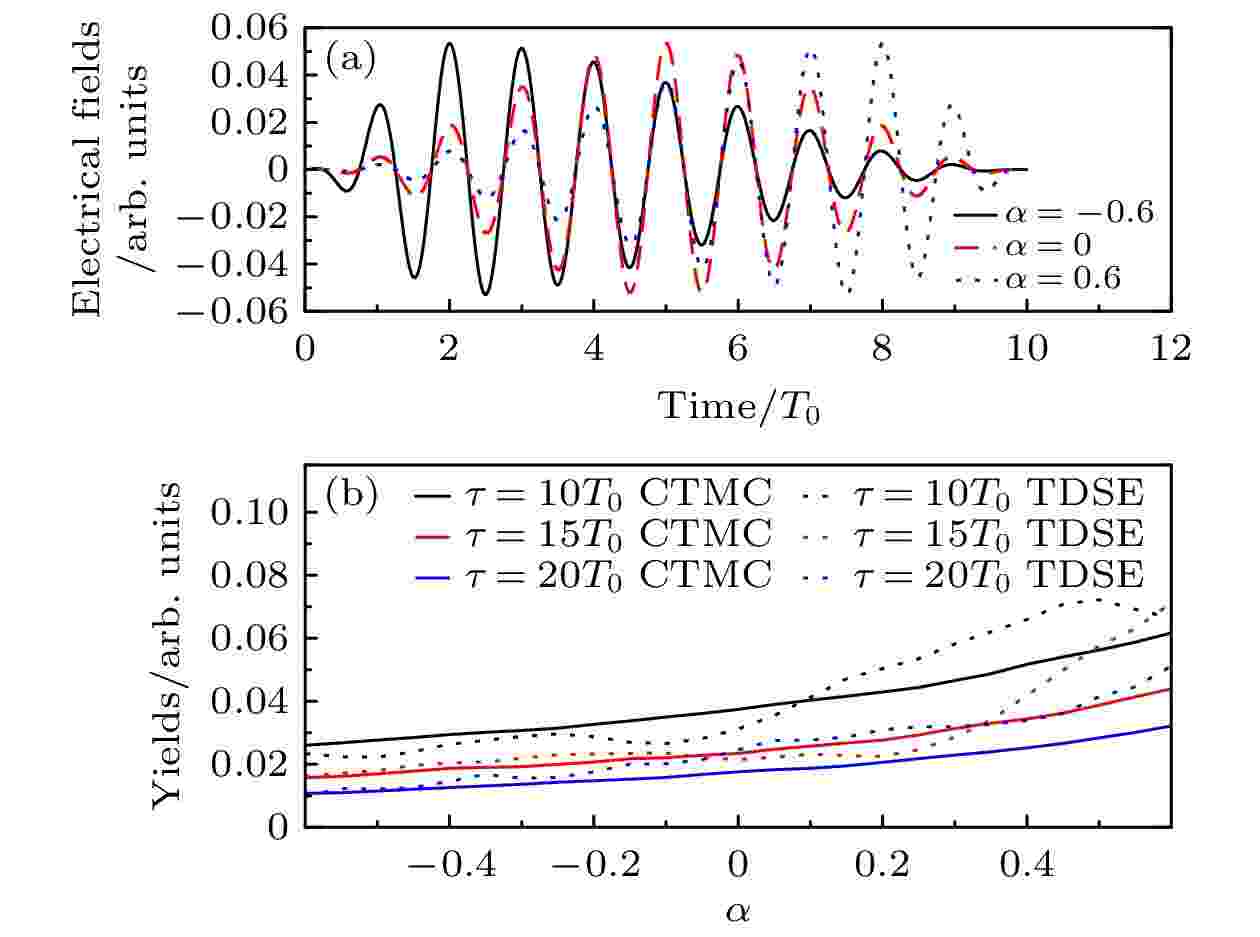
EDITOR'S SUGGESTION
2024, 73 (24): 243201.
doi: 10.7498/aps.73.20241222
Abstract +
Rydberg atoms are important building blocks for quantum technologies, and because of their unique tunable quantum properties, they possess new applications in quantum computing, quantum communication, and quantum sensing. Besides the widely-used few-photon resonant excitation for the specific Rydberg state, multiple Rydberg states can be populated coherently and efficiently through the frustrated tunneling ionization or the Coulomb potential recapture effect in a strong laser field. The excitation of Rydberg states in a strong field provides an opportunity for realizing the ultrafast quantum control on Rydberg atom and bridging the gap between strong field physics and quantum information technology. Using the classical trajectory Monte Carlo method and Qprop package to solve time-dependent Schrödinger equation, we calculate the population of Rydberg states. Our results show that the population increases with the increase of parameter of the asymmetric laser envelope. Based on the quantitative rescattering theory, the calculated time-dependent recapture rate is negatively related to the laser envelope and the residual laser interaction time, which is termed the envelope effect. Combined with the carrier-wave effect, an analytic formula can be used to calculate the Rydberg state population: $ Y(t) \propto $$ W_0\left(t\right) \dfrac{t-\tau+c}{f\left(t\right)} \cos \left(\omega t+\phi\right) . $ This result opens the way to enhancing the generation of Rydberg states by using the laser envelope control, which is beneficial to the future quantum technology based on the Rydberg states generated in the strong laser field.

EDITOR'S SUGGESTION
2024, 73 (24): 243301.
doi: 10.7498/aps.73.20241401
Abstract +
Coherent control of molecular dissociation in ultrafast strong fields has received considerable attention in various scientific disciplines, such as atomic and molecular physics, physical chemistry, and quantum control. Many fundamental issues still exist regarding the understanding of phenomena, exploration of mechanisms, and development of control strategies. Recent progress has shown that manipulating the spectral phase distribution of a single ultrafast strong ultraviolet laser pulse while maintaining the same spectral amplitude distribution can effectively control the total dissociation probability and branching ratio of molecules initially in the ground state. In this work, the spectral phase control of the photodissociation reaction of chlorobromomethane (CH2BrCl) is studied in depth by using a time-dependent quantum wave packet method, focusing on the influence of the initial vibrational state on the dissociation reaction. The results show that modifying the spectral phase of a single ultrafast pulse does not influence the total dissociation probability or branching ratio in the weak field limit. However, these factors exhibit significant dependence on the spectral phase of the single ultrafast pulse in the strong field limit. By analyzing the population distribution of vibrational states in the ground electronic state, we observe that chirped pulses can effectively control the resonance Raman scattering (RRS) phenomenon induced in strong fields, thereby selectively affecting the dissociation probability and branching ratio based on initial vibrational states. Furthermore, we demonstrate that by selecting an appropriate initial vibration state and controlling both the value and sign of the chirp rate, it is possible to achieve preferential cleavage of Cl+CH2Br bonds. This study provides new insights into understanding of ultrafast coherent control of photodissociation reactions in polyatomic molecules.
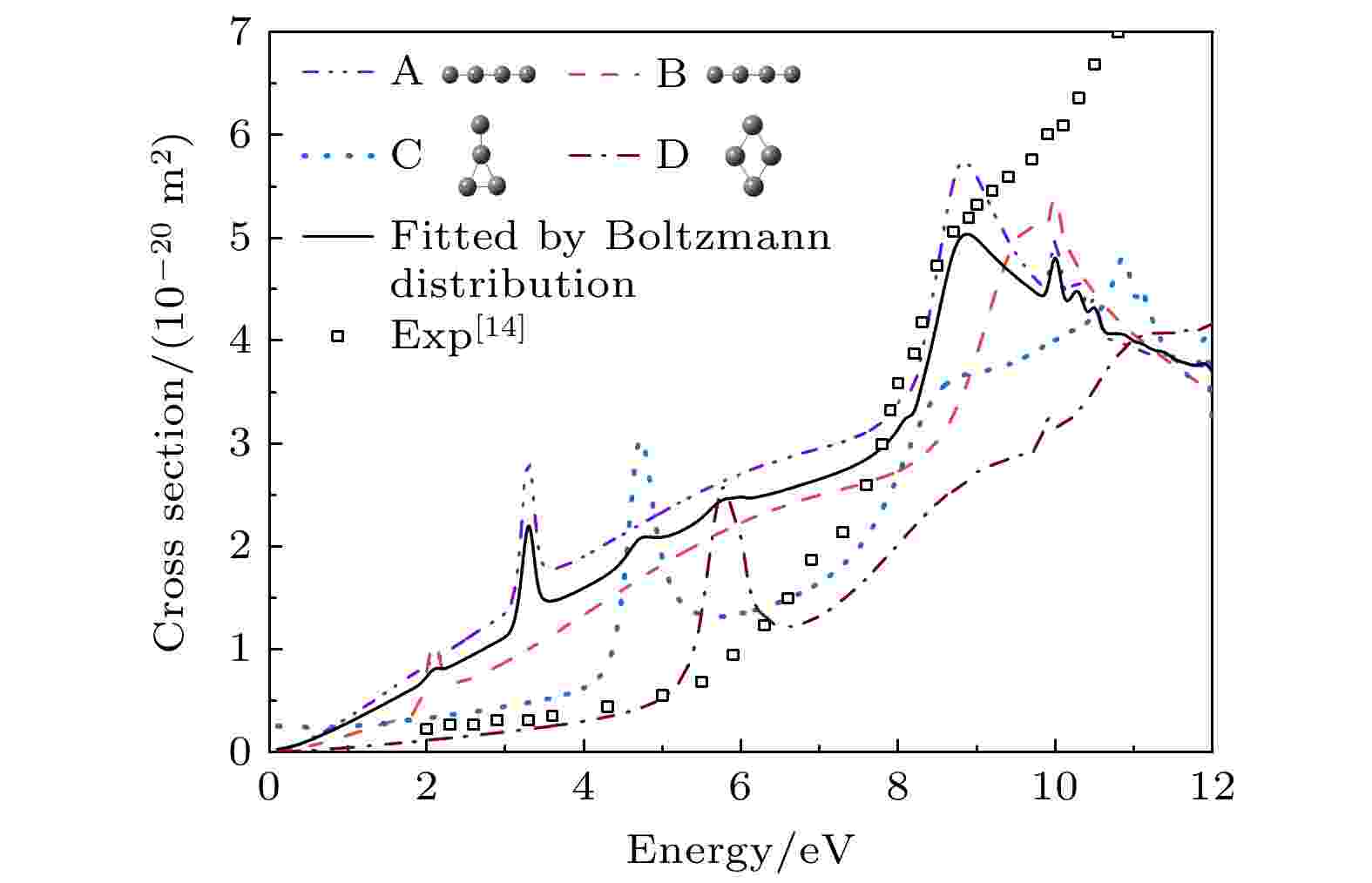
EDITOR'S SUGGESTION
2024, 73 (24): 243401.
doi: 10.7498/aps.73.20241377
Abstract +
This paper reports low-energy electron scattering with $ {{\mathrm{C}}}_{4}^{-} $ anions by using the ab initio R -matrix method in the single state close-coupling (CC) model and the fixed-nuclei approximation. We predict the elastic integral scattering cross sections (ICSs) of four conformers of $ {{\mathrm{C}}}_{4}^{-} $ ions in an energy range of 0 < E ≤12 eV and discuss the effects of configuration changes on resonance position and width. Additionally, the theoretical results and experimental data are compared and analyzed. The results indicate that the 8.8 eV resonance peak observed in experiment is mainly derived from the $ {{{\Sigma }}}_{{\mathrm{u}}}^{+} $ and $ {{{\Sigma }}}_{{\mathrm{u}}}^{-} $ resonances of the conformer A and the A2 resonance of the conformer C. The scattering cross-section reveals that the conformer A has five resonant states, and the conformer B has three resonances, while C and D each have four resonances. Finally, we use the Boltzmann distribution to calculate the populations of different conformers at different temperatures, and simulate the low-energy electron elastic integrated scattering cross-section at room temperature, which is in good agreement with available experimental results. We also find a shape resonance with a width of 0.20 eV at 3.3 eV in our total cross sections, which is not detected in the existing experimental results. This provides new opportunities for measurement.
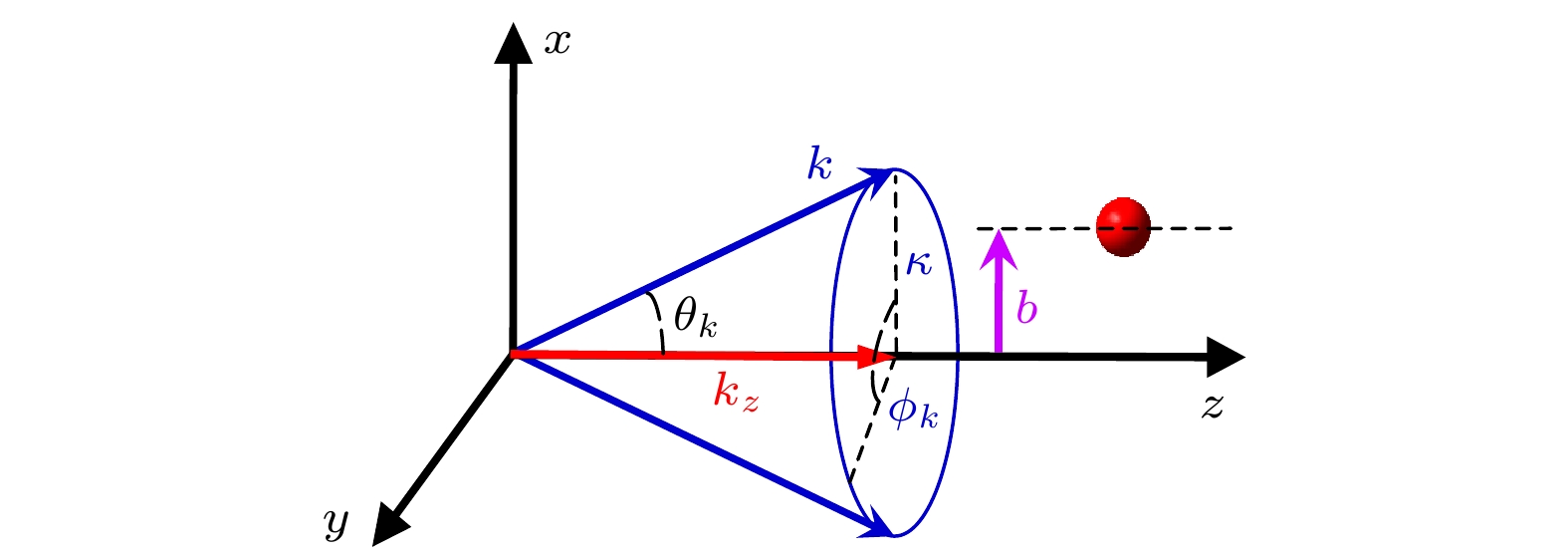
EDITOR'S SUGGESTION
2024, 73 (24): 244201.
doi: 10.7498/aps.73.20241378
Abstract +
Owing to vortex light possessing the additional orbital angular momentum, its interaction with atoms and molecules can reveal in more depth insights into dynamics than the plane wave light. This paper aims to establish a theoretical framework for the photoionization of atoms and molecules by Bessel vortex light. In the case of macroscopic gas target, helium atoms are randomly dispersed around the entire region of the Bessel vortex beam. The final photoionization cross-section is not dependent on the angular momentum of the vortex light, but depends on the opening angle of the Bessel vortex light. This paper systematically computes the variation of photoionization cross-section with photon energy and the angular distributions of photoelectrons under different geometric conditions. The computation results demonstrate that there is a significant difference in the photo-ionization cross-section between vortex light and plane wave light. In order to further investigate the characteristics of the phase singularity of the vortex light (when the light intensity reaches zero), this paper further calculates the photo-ionization of the vortex light with opening angles of 5°, 30°, and 60° at the phase singularity, respectively. The results indicate that the angular distribution of photoelectrons at these three angles is significantly dependent on the orbital angular momentum and the opening angle of the vortex light, and the calculated absolute cross-section does not equate to zero. This represents an important distinguishing feature of the Bessel vortex light when interacting with atoms, distinguishing it from the plane wave. This work lays the foundation for further studying vortex light photo-ionization and their applications.
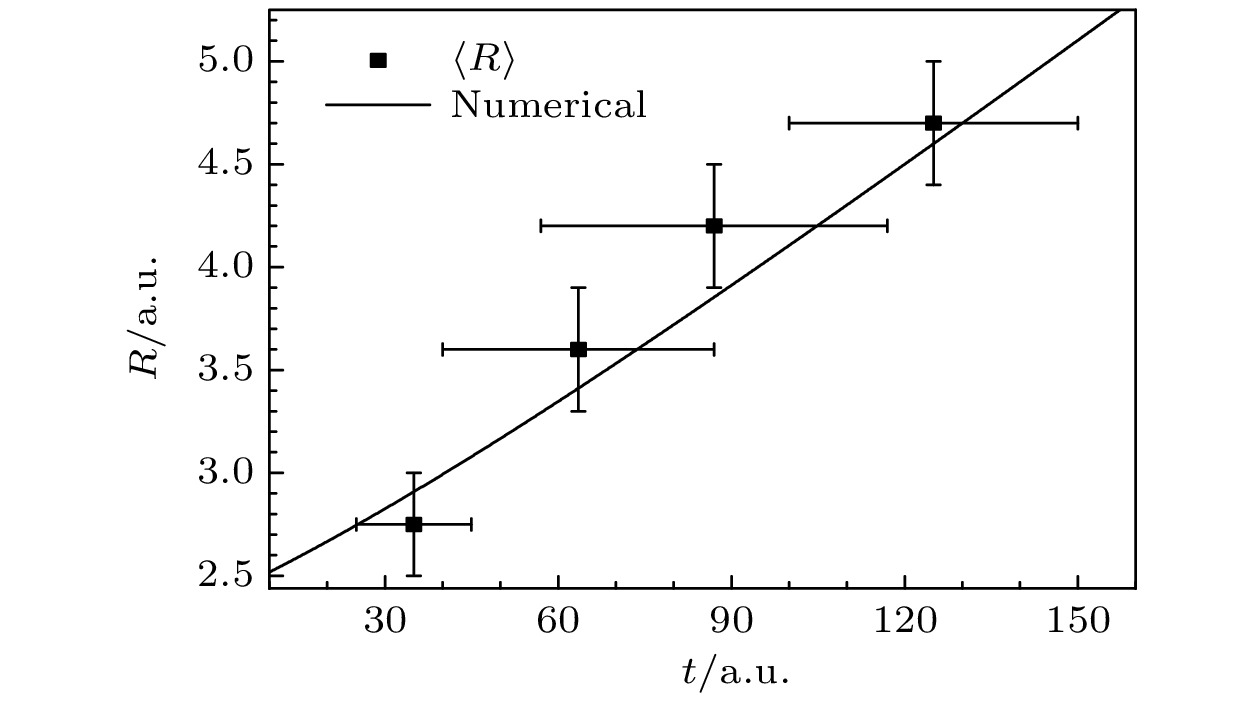
EDITOR'S SUGGESTION
2024, 73 (24): 248201.
doi: 10.7498/aps.73.20241283
Abstract +
In recent years, the rapid development of ultrashort pulse laser technology has made it possible to regulate the ionization and dissociation dynamics of atoms and molecules. Among them, the microscopic dynamics of molecular dissociation have always been a hot topic. The phenomenon of molecular dissociation, which is caused by the interaction between femtosecond intense laser fields and $\text{H}_2^+$ molecules, has attracted widespread attention. Previous theoretical studies on the dissociation of $\text{H}_2^+$ molecules mainly focused on studying its dissociation dynamics through numerical calculations, with relatively few theoretical models. This paper aims to establish a simple classical model to describe the dissociation dynamics. Firstly, this paper calculates the joint distribution of nuclear energy and electronic energy in the dissociation process of $\text{H}_2^+$ molecules under the action of pump lasers by numerically solving the Schrödinger equation. The results prove that $\text{H}_2^+$ molecules initially in the ground state are dissociated into ${\rm H}^+ + {\rm H}^*$ after absorbing a pump photon in the pump light field. Next, this paper studies the dissociation dynamics of $\text{H}_2^+$ molecules in time-delayed two-color femtosecond lasers. We find that it greatly depends on the specific forms of the pump light and the probe light. By utilizing the dependence of the dissociation kinetic energy release (KER) spectrum on the time delay of the two-color femtosecond lasers, we retrieve the sub-attosecond microscopic dynamic behaviors of electrons and atomic nuclei in the dissociation process. Furthermore, we establish a classical model based on the conservation of energy and momentum to describe the dissociation dynamics. This model can qualitatively predict the ion dissociation KER spectrum depending on the time delay of the two-color femtosecond lasers. The electronic resonant transition between the molecular ground state and the first excited state caused by the probe light will affect the ion kinetic energy spectrum in the dissociation process. Namely, the ion kinetic energy spectrum is dependent on the frequency of the probe laser. By taking advantage of this characteristic, we propose a scheme to reconstruct the evolution of the internuclear distance with time. Our reconstruction results can qualitatively predict the trend of the numerical simulation results, and this scheme may provide some theoretical guidance for experiments.
REVIEW
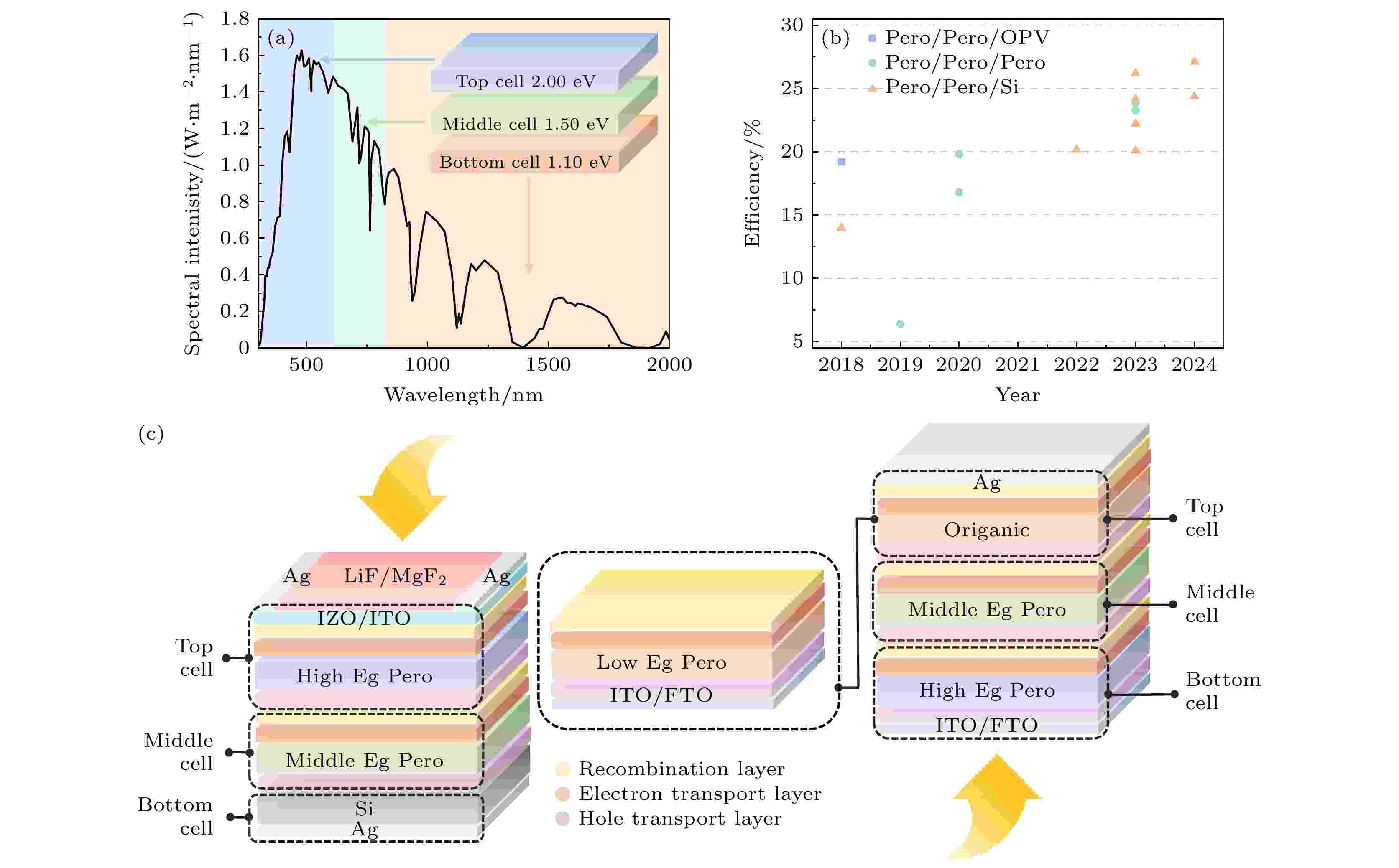
EDITOR'S SUGGESTION
2024, 73 (24): 248802.
doi: 10.7498/aps.73.20241187
Abstract +
The energy conversion efficiency of single-junction solar cells is limited by the Shockley-Queisser theory and the most effective strategy to break through this limit is to fabricate multi-junction tandem solar cells. Perovskite materials provide a continuously tunable energy band structure, offering a new option for light-absorbing materials in multi-junction tandem cells. In the field of perovskite-based multi-junction tandem solar cells, triple-junction tandem solar cells have demonstrated great potential. The present paper introduces the configuration of triple-junction solar cells and its facing three scientific challenges. 1) Ensuring energy level alignment among sub-cells is a critical concern for three-junction batteries. Specifically, the top wide-band gap sub-cell must possess a band gap ranging from 1.8 to 2.2 eV; however, current perovskite material systems with wide-band gaps exhibit certain defects. 2) It is essential to achieve current matching in multi-junction tandem solar cells while optimizing the absorption layer and minimizing parasitic absorption in order to maximize the current output of solar cells. 3) The functional layers of multi-junction tandem solar cells are stacked sequentially using different deposition methods, which imposes higher compatibility requirements on the intermediate interconnect layers. Subsequently, the research progress of perovskite-based triple-junction tandem solar cells is introduced, including perovskite/perovskite/silicon tandem solar cells, perovskite/perovskite/organic tandem solar cells, and all-perovskite tandem solar cells. Their respective highest efficiencies are 19.4%, 23.87%, and 27.1%. Finally, this paper explores the research directions for further improving the performance of triple-junction solar cells. In addition to improving energy conversion efficiency, perovskite-based solar cells must also solve the stability problems in order to achieve future commercialization, and provide guidance for the development of efficient triple-junction cells.
GENERAL
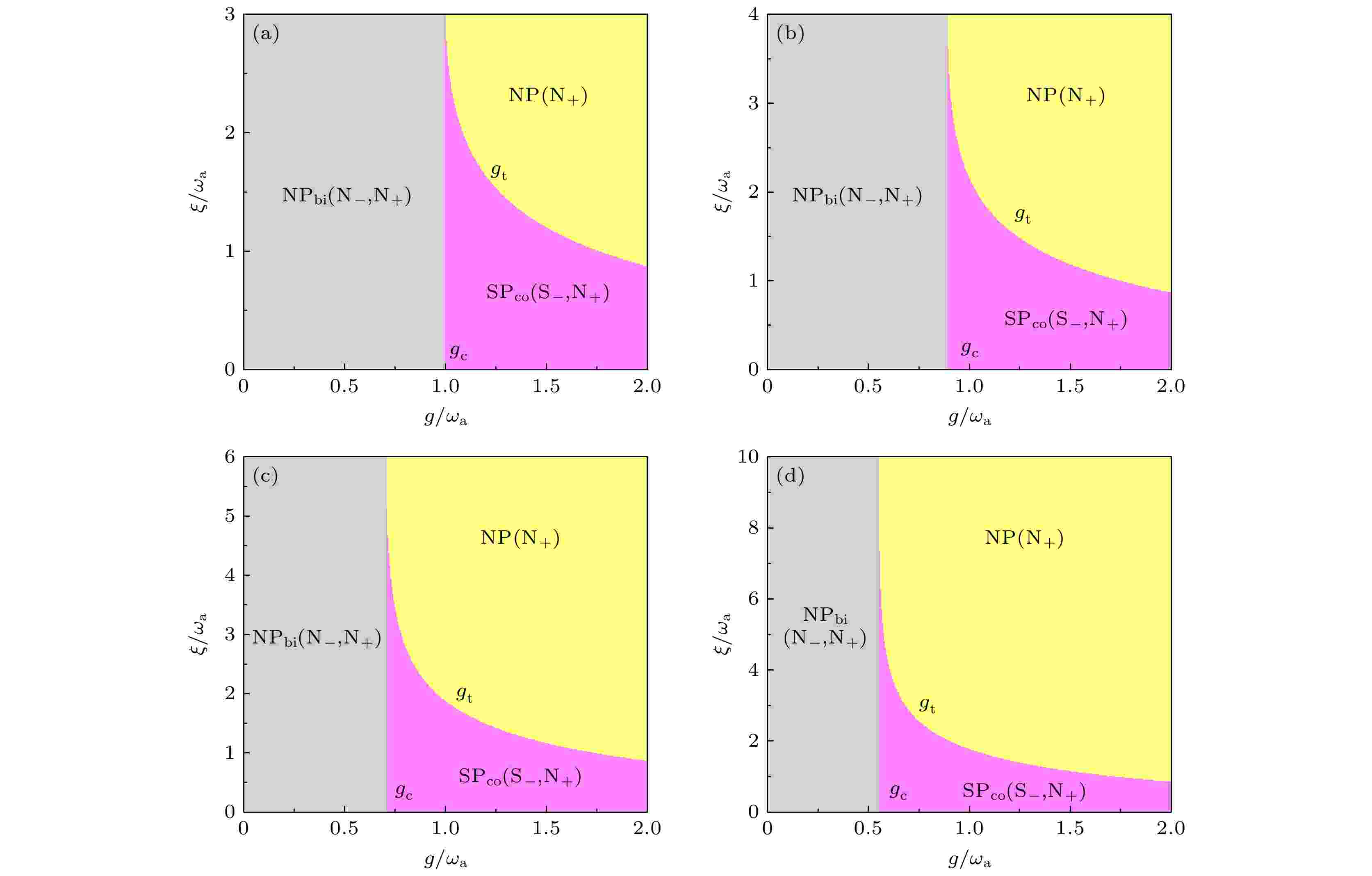
EDITOR'S SUGGESTION
2024, 73 (24): 240301.
doi: 10.7498/aps.73.20241103
Abstract +
In this paper, the quantum phase transition of cold atoms in a two-mode photomechanical cavity with nonlinear coupling between the optical field (mode 1) and the mechanical oscillator is studied on the basis of the two-mode Dicke model. The functional of the ground state energy of the system is obtained by spin coherent states and variational method. By solving and judging the stability, the phase transformation point and ground state phase diagram are obtained. It is found that there are bistable state of normal phase and reverse normal phase, coexistent state of superradiation phase and reversed normal phase, and reversed normal phase that exists alone. The different interaction strengths between atoms and two-mode light fields greatly affect the value of the phase transition point. There is a quantum phase transition from a normal phase through a phase transition point to a superradiant phase. The light-phonon nonlinear coupling has no effect on the phase transition point, but induces the collapse of the superradiant phase. There is a turning point through which the quantum phase transition from the superradiant phase to the reversed normal phase can be realized. The region of the superradiation phase decreases with the increase of the photon-phonon coupling, and it shrinks to zero at the critical value of the coupling, that is, the turning point and the phase transition point coincide, and there may be a reversal of the atomic population between the two normal phases. The nonlinear coupling of the light-phonon also produces an unstable non-zero photon state, which corresponds to the superradiation state. In the absence of mechanical oscillators, the results of the two-mode Dicke model are returned.
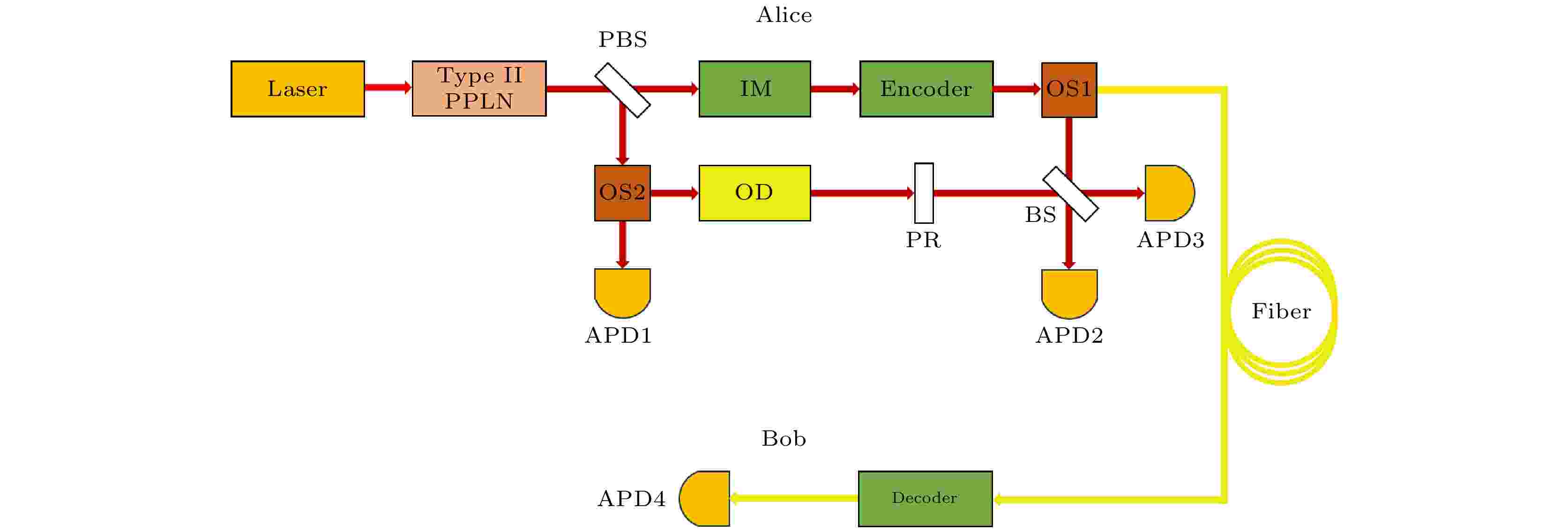
EDITOR'S SUGGESTION
2024, 73 (24): 240302.
doi: 10.7498/aps.73.20241269
Abstract +
ATOMIC AND MOLECULAR PHYSICS

2024, 73 (24): 243402.
doi: 10.7498/aps.73.20241355
Abstract +
The elastic collision cross-section is a key parameter in the study of inter-particle interactions, and it helps to reveal the microscopic mechanism of gas insulation. For this reason, based on the R -matrix theory, the elastic collision cross-sections of 24 gas molecules at 0–15 eV are calculated , and cross-section characteristic parameters of the lowest resonance state energy and its peak are extracted. Then the calculated and experimental values of SF6, CF2Cl2, and i-C3F7CN cross-sections are compared, and the low-energy cross-section data of i-C3F7CN at 0–1 eV are given. Furthermore the effects of Cl-substitution and carbon chain length on the cross-section parameters are analysed. Finally the correlation between cross-section characteristic parameters and insulation strength is investigated. The results show that the lowest shape resonance state energy for each molecule is in better agreement with the existing data within a mean square error of 0.181. For the F-substitution, the resonance energy gradually increases but the peak value gradually decreases, which the carbon chain extension is the opposite to: the resonance state energy gradually decreases but the peak value gradually increases. The lowest resonance energy and peak value are strongly related to the insulation strength. The lower its lowest resonance energy and the larger the corresponding peak value, the higher the molecular insulation strength is. The relevant data can theoretically supplement existing experimental data. This study provides low energy cross-section properties of various insulating gas molecules, which can be useful for qualitatively evaluating the insulating properties of gas molecules and quickly screening SF6 alternative gases.
ELECTROMAGNETISM, OPTICS, ACOUSTICS, HEAT TRANSFER, CLASSICAL MECHANICS, AND FLUID DYNAMICS
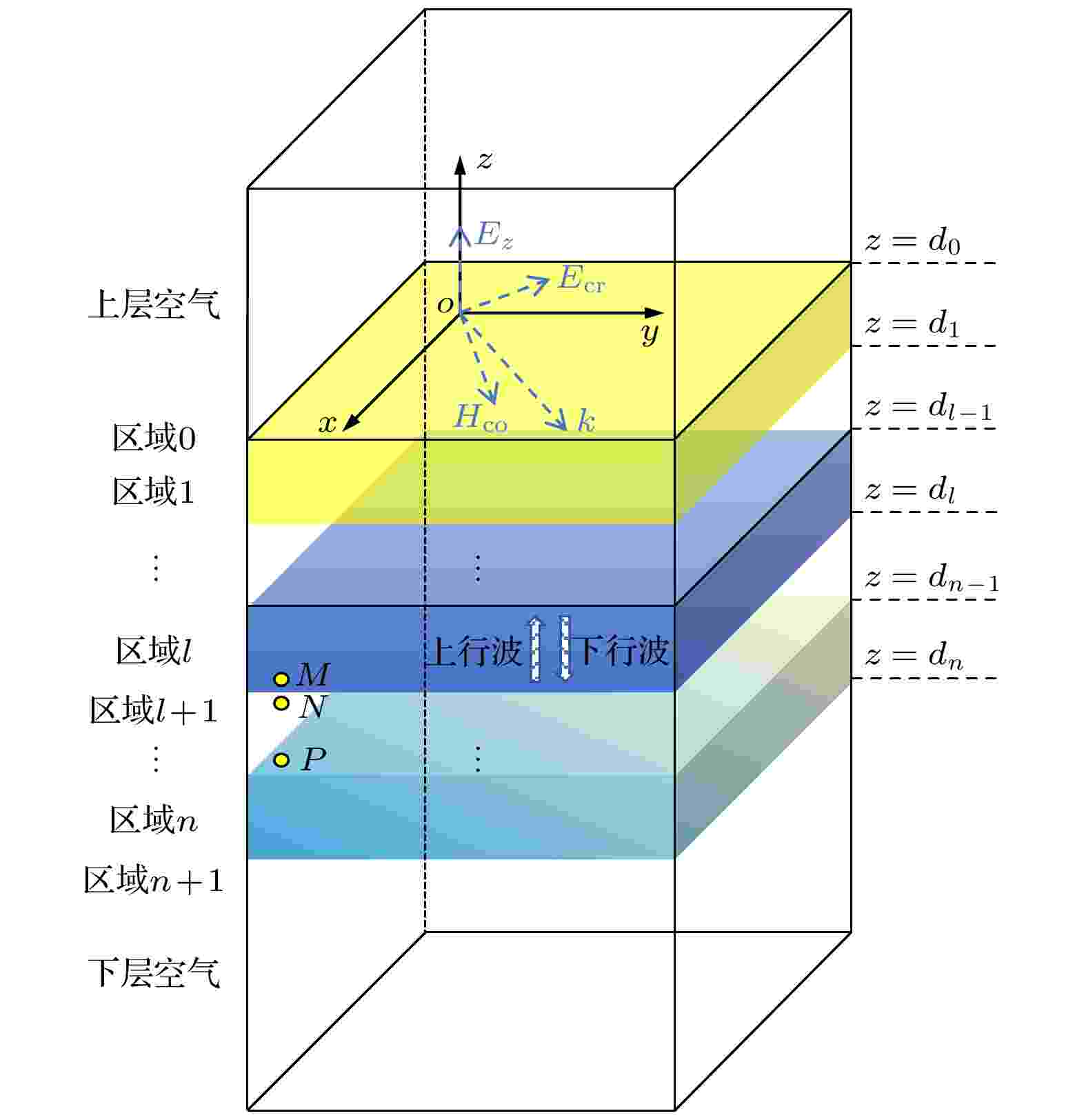
2024, 73 (24): 244101.
doi: 10.7498/aps.73.20241346
Abstract +
Uniaxial/biaxial bianisotropic materials are widespreadly used in manufacturing optical devices , owing to their distinctive electromagnetic response characteristics. To effectively analyze the electromagnetic properties of uniaxial/biaxial bianisotropic materials, rapid-transfer matrix method (R-TMM) to investigate the propagation process of plane waves in the media is proposed. Starting from the Maxwell’s equations in the time domain, a homogeneous differential equation about the electric field is constructed by processing the matrix containing dielectric and magnetic conductivity, electric and magnetic loss, tellegen and chirality carrier parameters, and the complex matrix operation is applied to that equation to obtain the Booker quartic equation, and then the formulae method is utilized to obtain the eigenvalues in the uniaxial/biaxial bianisotropic media. Subsequently, the tangential continuity of layered media at the interface is employed to establish a transfer matrix for single-layered media. In the case of multi-layered media, the transfer matrix of plane waves propagating in multi-layered uniaxial/biaxial bianisotropic media can be obtained by means of a continuous iteration process based on the transfer matrix of single-layered media. The formula for calculating the propagation coefficients of uniaxial/biaxial bianisotropic materials can be derived based on the different upward and downward waves in the reflection/transmission region. Finally, the reliability and efficiency of R-TMM are verified from two numerical experiments with the plane waves incident at different angles on uniaxial/biaxial bianisotropic media. The first experiment is designed as a single-layered biaxial bianisotropic model with more general electromagnetic parameters, and the second experiment is designed as a double-layered uniaxial and biaxial bianisotropic model consisting of common optical materials, which are composed of two non-magnetic materials, lithium niobate (LiNbO3) and cadmium sulfide (CdS). The experimental results demonstrate that compared with the conventional conventional-transfer matrix method (C-TMM), the R-TMM reduces the computational memory and CPU time required for calculating the reflection and transmission coefficients of the uniaxial/biaxial bianisotropic model by over 98%, while maintaining the accuracy of the reflection and transmission coefficient calculations. Therefore, R-TMM provides an efficient and dependable approach for the designing complex optical devices and analyzing uniaxial/biaxial bianisotropic propagation characteristics.
PHYSICS OF GASES, PLASMAS, AND ELECTRIC DISCHARGES
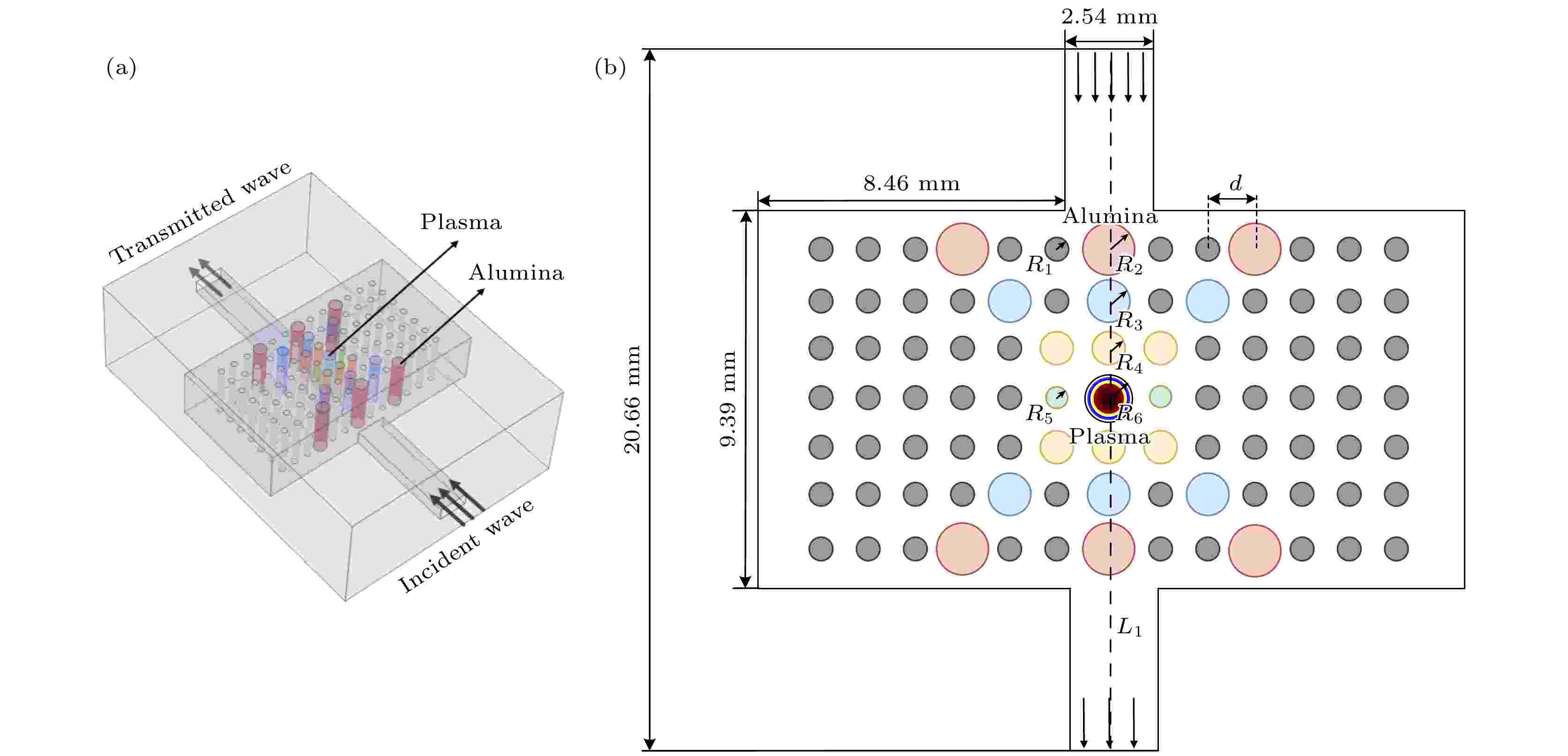
2024, 73 (24): 245201.
doi: 10.7498/aps.73.20241300
Abstract +
Photonic crystal with periodic dielectric constant distribution has become the focus of theoretical and applied research in recent years because of their bandgap structure similar to the electronic states in semiconductors. It is also a promising method of creating a stable low power microplasma. This research field makes it possible to explore plasma science using microplasmas driven by millimeter wave bands. The dispersive and dissipative properties of plasma make plasma photonic crystals have properties that conventional dielectric photonic crystals do not have. The properties and parameters of plasma photonic crystal can be artificially controlled by changing the parameters of the plasma. To further investigate the influence of photonic crystals on electromagnetic wave transmission, a waveguide model with a plasma photonic crystal array structure is proposed in order to achieve modulation of electromagnetic wave transmission. This proposed model structure can achieve multiple frequency transmission points, making up for the shortcoming of single frequency point transmission in the W-band. Meanwhile, adding a plasma column to the center of defect vacancy in the gradient structure can limit the amplitude of electromagnetic waves and regulate the transmission of electromagnetic waves at different resonant frequencies. The results show that electromagnetic wave can achieve efficient transmission at multiple frequency points such as 85.2, 92.1, 98.5, 102.4, 106 GHz without plasma interference, and transmission coefficients are greater than –0.42 dB. The construction of gradient structure can form different strong electric fields around the defect vacancy at the resonance frequency, resulting in gas breakdown and the generation of high-concentration microwave plasma, achieving effective control of the reflected power, transmitted power and absorbed power of electromagnetic wave. When the plasma concentration reaches the plasma frequency equivalent to the incident wave frequency, the electromagnetic wave can be transmitted with less loss in this period. When it achieves a considerable degree or higher, the electromagnetic wave will be rapidly absorbed or reflected by the high concentration plasma, and the transmission power will decrease rapidly, and finally stabilize at a low level. In addition, changing the size of the plasma column can further adjust the transmission characteristics of electromagnetic waves at different frequency points. This research can provide support for the transmission of high-frequency electromagnetic waves and the design of microwave devices.

2024, 73 (24): 245202.
doi: 10.7498/aps.73.20241331
Abstract +
As one of the key design parameters of Hall thruster, magnetic field indirectly influences the macroscopic performance of the thruster by directly affecting electron transport, neutral atom ionization, plasma distribution and other microscopic behaviors. At present, the research on the influence of Hall thruster’s magnetic field focuses mostly on the size and distribution of the magnetic field in the discharge channel, but less on the influence of the plume magnetic field on the thruster. Based on this, the effect of plume region axial magnetic field profile on the performance of Hall thruster is studied by using two-dimensional hybrid simulation. The research results show that the axial magnetic field gradient in the plume region has a significant influence on the thruster performance, when the magnetic field characteristics (magnetic field topology and magnetic field intensity) in the discharge channel remain unchanged. The potential drop in the discharge channel decreases with the axial magnetic field gradient in the plume region decreasing. However, the electric field in the plume region and the peak ion number density in the discharge channel increase with the axial magnetic field gradient in the plume region decreasing. Overall, the performance of the thruster is improved by increasing the magnetic field strength in the plume region. More specifically, there is a critical value of axial magnetic field gradient in the plume region. When the axial magnetic field gradient in the plume region is greater than the critical value, the thrust increases with the axial magnetic field gradient decreasing. When the axial magnetic field gradient of the plume region is less than the critical value, the thrust decreases slightly with the axial magnetic field gradient decreasing. The comparison of plasma potential, electric field, ion number density, and ionization rate distribution under different magnetic field distributions in the plume region shows that the effect of plume magnetic field on thrust is to affect the spatial electric field distribution by affecting the mobility of electrons, thus causing the thrust to change due to electric field. The research results of this paper will provide theoretical support for improving the performance of hall thrusters and designing magnetic fields.
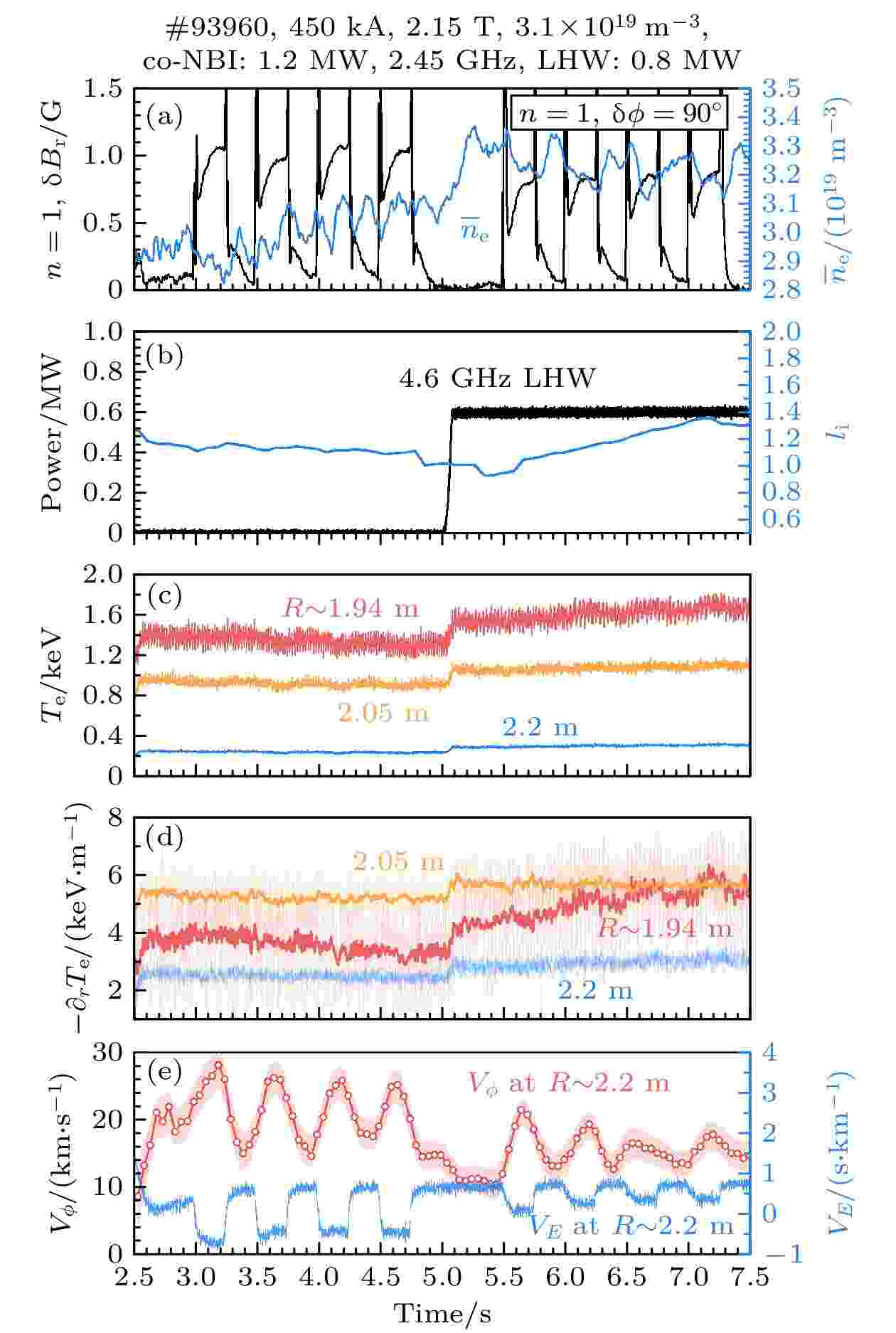
EDITOR'S SUGGESTION
2024, 73 (24): 245203.
doi: 10.7498/aps.73.20241357
Abstract +
Plasma spontaneous rotation significantly affects confinement performance and stability in tokamaks. Effectively inducing this rotation is essential for stabilizing resistive wall modes (RWMs) and ensuring the stable operation of the International Thermonuclear Experimental Reactor (ITER). Recent experiments conducted on the Korea Superconducting Tokamak Advanced Research (KSTAR) device demonstrated that resonant magnetic perturbations (RMPs) can induce neoclassical toroidal viscosity (NTV) torque under certain conditions, successfully driving plasma rotation. Similarly, on the Experimental Advanced Superconducting Tokamak (EAST), an increase in plasma rotation in the direction of the plasma current has been observed following RMP application. However, unlike the KSTAR findings, the NTV torque simulations for EAST are two orders of magnitude lower than experimental measurements, indicating additional mechanisms beyond NTV may drive the observed plasma rotations. In this paper, to investigate these mechanisms, momentum balance, causality, and statistical analyses are performed at EAST. An increase in rotation velocity is found to correlate with significant changes in the ${\boldsymbol{E}}\times{\boldsymbol{B}}$ flow, matching the RMP-induced torque distribution. This alignment suggests that residual stress, arising from variations in ${\boldsymbol{E}}\times{\boldsymbol{B}}$ shear, may cause the observed rotation to increase. The effects of stochastic fields on multi-scale turbulence are considered as a possible explanation for correlations between ${\boldsymbol{E}}\times{\boldsymbol{B}}$ velocity and toroidal rotation. Stochastic fields appear to enhance the inertia of large-scale turbulence while driving small-scale turbulence to maintain quasi-neutrality. The resulting turbulent Reynolds stress, generated by small-scale turbulence, may account for the increases of the observed ${\boldsymbol{E}}\times{\boldsymbol{B}}$ velocity during RMP application. Statistical analysis further highlights the importance of island width in understanding the threshold RMP current in ramping-up RMP experiments, supporting the conclusion that turbulence-driven ${\boldsymbol{E}}\times{\boldsymbol{B}}$ shear-related residual stress is the key mechanism of driving plasma rotation following RMP application.

2024, 73 (24): 245204.
doi: 10.7498/aps.73.20240720
Abstract +
Low-frequency hysteresis flow and pulsating pressure caused by underwater explosion bubbles can cause overall damage to ships. The hydrodynamic and energy conversion of bubbles are very important in studying underwater explosion bubbles. At present the study of bubble dynamics is based on ideal gas hypothesis, which does not involve heat exchange and is only suitable for bubbles of chemical detonating, but not for bubbles at higher temperatures. The evolution of underwater explosion bubbles is studied experimentally by underwater exploding wire. There is obvious heat exchange during the evolution of bubbles, which is different from bubble behavior in chemical detonating underwater. This study focuses on pulsating behavior and energy characteristic of bubbles, and the difference from chemical detonating as well. The experimental facility is mainly composed of two parallel energy storage-discharge modules and a water tank. Each module is composed of two 20 μF capacitors connected and a gas switch connected in series with these two capacitors. A copper wire with a diameter of 0.9 mm and a length of 50 mm is used as a load. The experimental results show that the deposited energy density generated by electric explosion is almost equal to that of TNT. The wire plasma expansion produces an initial bubble with temperature of radially spatial distribution. The total pulsation frequency of bubble will not exceed 4 times. After energy exhaustion, bubbles collapse directly into water because the main component is condensable gas. The comparison of the experimental data with the existing theoretical models shows that the vaporization of water in bubble expansion stage leads to certain energy loss, which makes difference in motion trajectory of bubbles between the simulation and the experiment. This study provides ideas and data support for the dynamical study of high temperature bubbles in underwater explosion.
CONDENSED MATTER: STRUCTURAL, MECHANICAL, AND THERMAL PROPERTIES
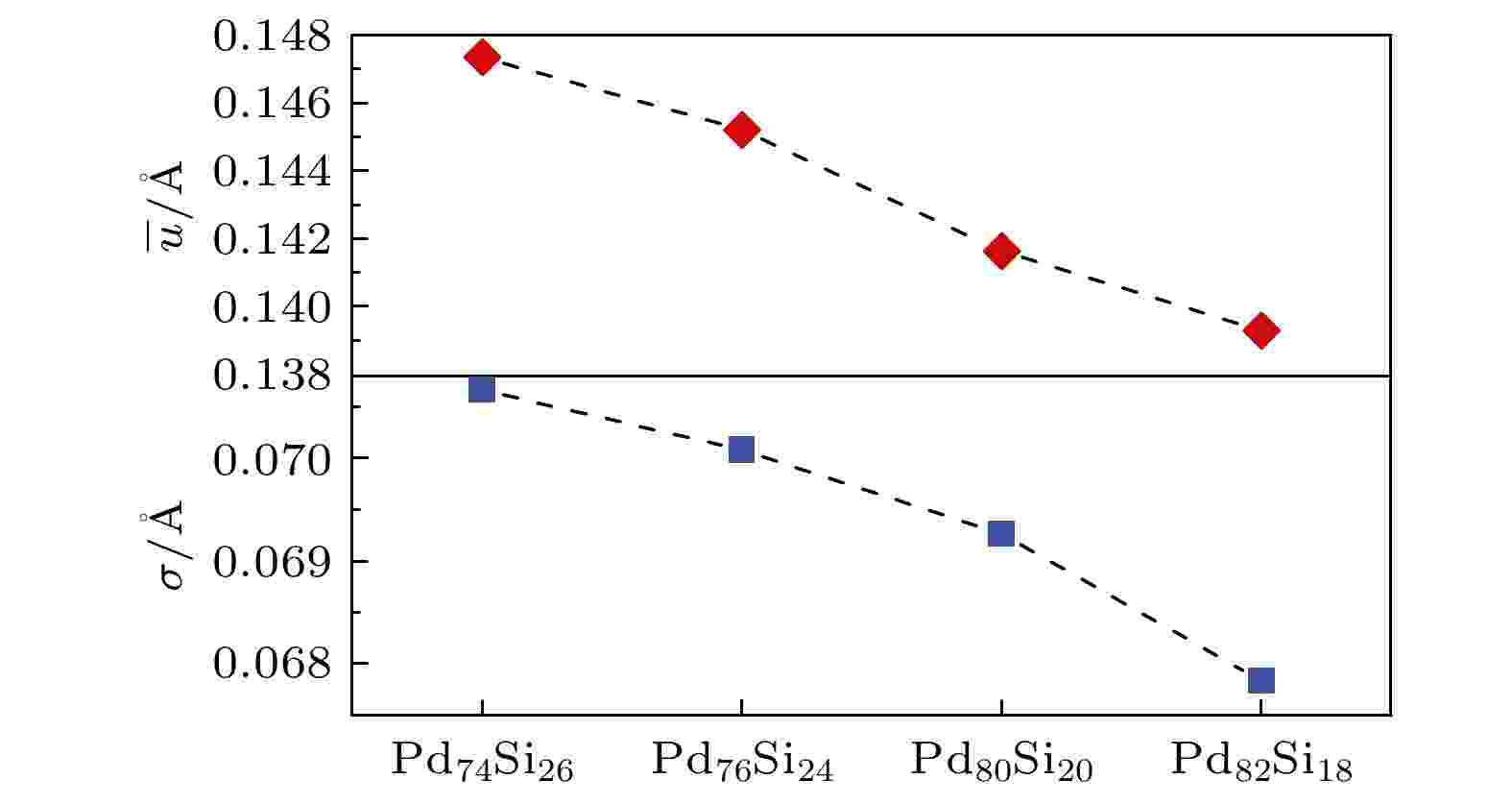
2024, 73 (24): 246102.
doi: 10.7498/aps.73.20241051
Abstract +
In amorphous alloys, the atomic arrangement exhibits short-range order while lacking long-range order. Despite the lack of long-range order, the local atomic arrangements and interactions can still significantly affect the motion of atoms. The microstructural features and structural evolution mechanisms of amorphous materials are key areas of research, and the dynamics of amorphous alloys can provide insights into their formation process and structural evolution. The cage effect refers to the phenomenon where atoms are trapped by their surrounding atoms, making them difficult to migrate or diffuse freely. This leads to slower diffusion rates and higher viscosities in these materials. Atomic concentration is one of the crucial factors that influence the structures and properties of amorphous materials. Variation in concentration can significantly change the material’s structure. Adjusting the atomic concentration can lead to the difference in diffusion rate between elements in the amorphous alloys, resulting in heterogeneous distributions of elements in different regions, which in turn affects the deformation characteristics of amorphous materials. This study aims to investigate the effect of Pd atomic concentration on the diffusion hindrance of Si atoms, as well as its influence on the local symmetry and order of the system. To achieve this objective, molecular dynamics simulations are employed to explore the relaxation process of atoms in Pd-Si amorphous alloys at different Pd atomic concentrations, and parameters related to atomic diffusion, displacement distribution, system symmetry, and order are analyzed. The results show that increasing the concentration of Pd atoms leads to a more significant hindrance to the diffusion of Si atoms, manifested as an increase in the abnormal peak values of the non-Gaussian parameters and a decrease in the standard deviation of the displacement. This indicates that a higher Pd atom concentration enhances the cage effect of Si atoms, thus restricting their diffusion. Additionally, the increase in Pd concentration promotes the transition from unsaturated to saturated bond type in the Pd-Si amorphous alloy, and also leads the system’s configurational entropy to decrease. This consequently enhances the local symmetry and order of the Pd-Si amorphous alloys, leading Si atoms to be located in the center of more closed, higher-symmetry, and more compact cluster structure, which strengthens their cage effect and local symmetry. This study investigates the influence of Pd atom concentration on the diffusion behavior and local environment of Si atoms, providing a new insight into the structural evolution of amorphous alloys.
CONDENSED MATTER: ELECTRONIC STRUCTURE, ELECTRICAL, MAGNETIC, AND OPTICAL PROPERTIES
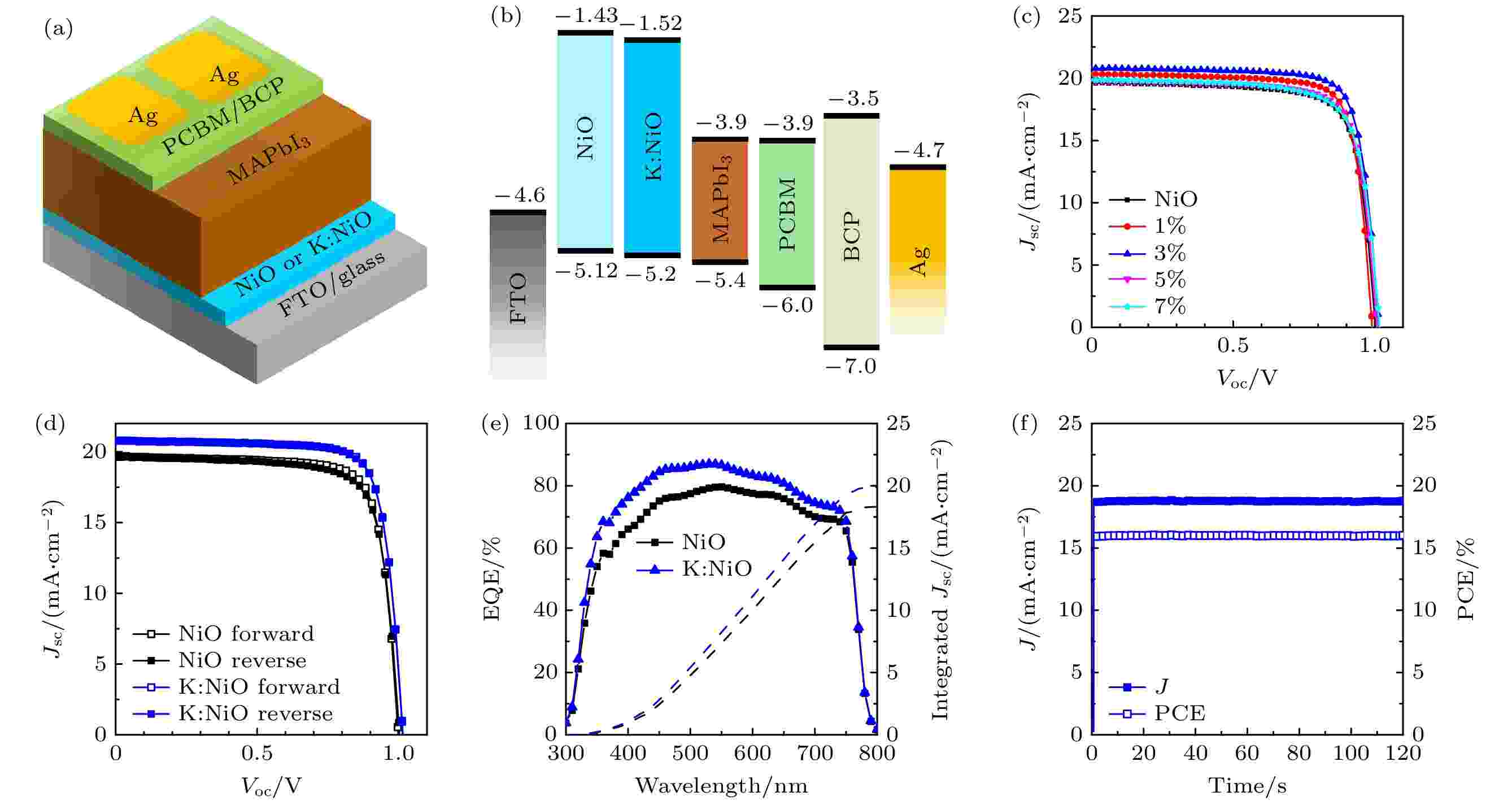
2024, 73 (24): 247801.
doi: 10.7498/aps.73.20240974
Abstract +
Perovskite solar cells (PSCs) with inverted structures have received significant attention in the field of photovoltaics. NiO is one of the commonly explored hole transport materials (HTMs) because of its excellent chemical stability in comparison with organic materials. Pure NiO is an insulator, but the presence of nickel vacancies can lead to the formation of Ni3+ ions, resulting in p-type semiconductor properties. However, the low conductivity and poor interfacial contact between NiO and perovskite thin films still pose challenges in achieving high-performance inverted PSCs. To solve these problems, potassium acetate is used as a potassium source for a nickel precursor, and therefore potassium ions (K+) are doped into NiO nanocrystals. The introduction of K+ into NiO leads to the formation of Ni3+ ions, thereby increasing the conductivity and hole mobility of NiO. Furthermore, K+-doped NiO exhibits better interface contact with the perovskite film, facilitating the efficient separation of photo-generated charges and showing a strong photoluminescence quenching effect. Experimental results demonstrate that the optimal concentration of K+ doping is 3%, and the PSCs prepared with K+-doped NiO exhibit a significant increase in efficiency, from 15.15% to 16.75%, which is attributed primarily to the improvements in the short-circuit current density and fill factor. These improvements highlight the importance of enhanced conductivity and better interfacial contact achieved through K+ doping for charge carrier collection, effectively addressing the limitations of NiO in inverted PSCs.
INTERDISCIPLINARY PHYSICS AND RELATED AREAS OF SCIENCE AND TECHNOLOGY
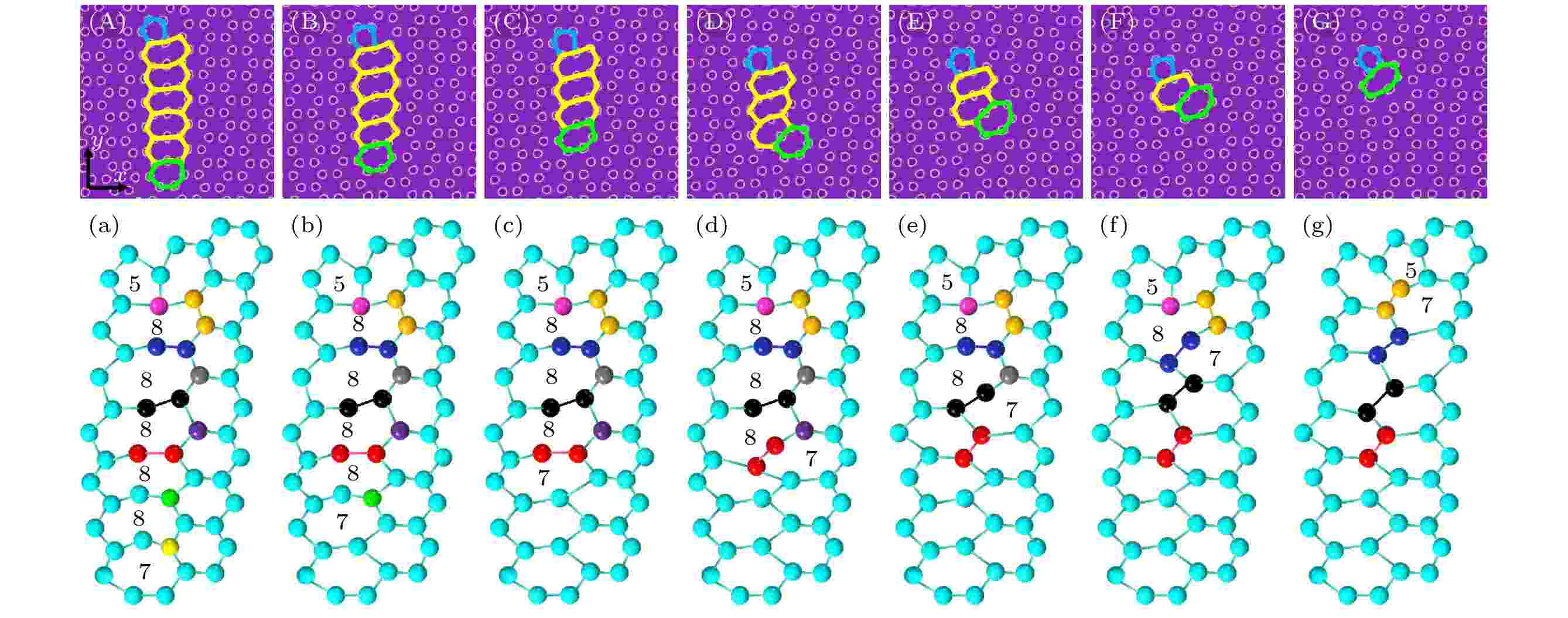
2024, 73 (24): 248101.
doi: 10.7498/aps.73.20241368
Abstract +
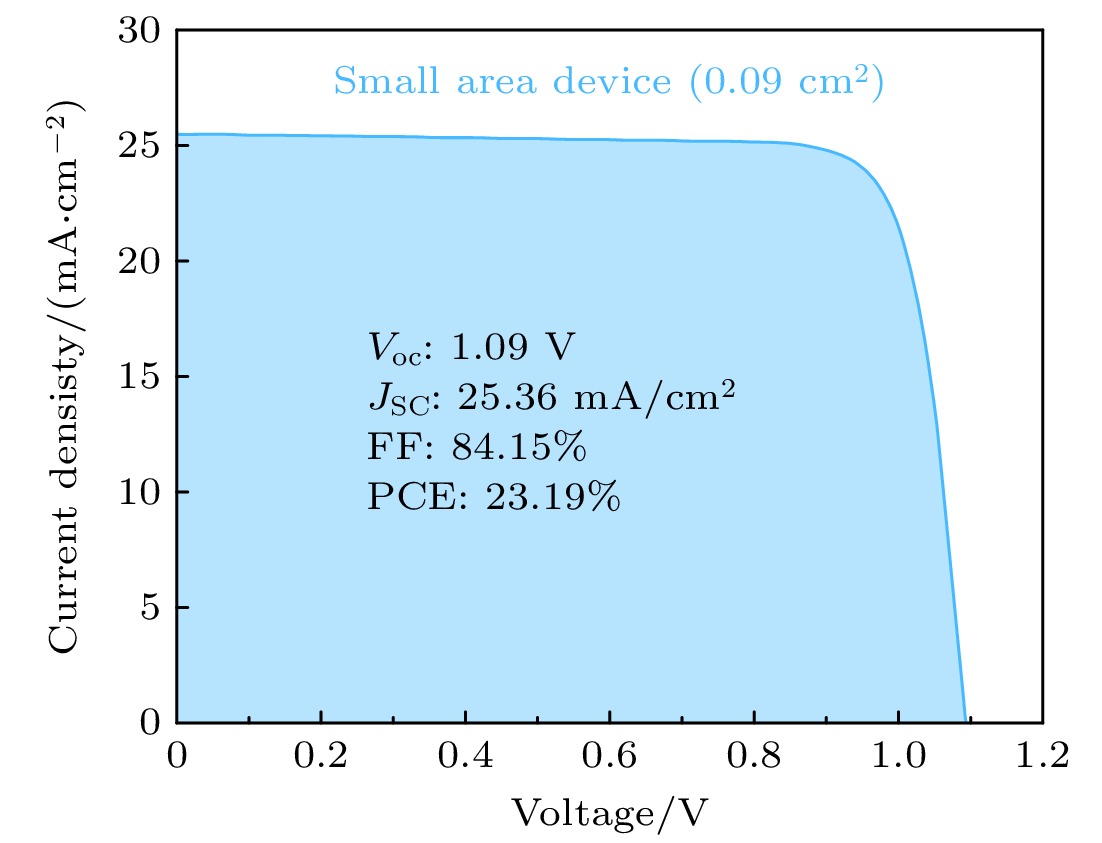
2024, 73 (24): 248401.
doi: 10.7498/aps.73.20241238
Abstract +
Inverted (p-i-n) perovskite solar cells (PSCs) are receiving increasing attention due to their high conversion efficiency and good stability. The main factor restricting the efficiency improvement of inverted perovskite cells is the interface defect between the perovskite layer and the charge transport layers. Therefore, the dual modification strategy of 1, 3-diaminopropane dihydroiodide (PDADI) passivates the interface defects between perovskite films and charge transport layers, improves the quality of perovskite film formation, suppresses non radiative recombination between perovskite films and charge transport layers as well as improved charge carrier transport, and results in a conversion efficiency of 23.19%. Furthermore, the unencapsulated PSCs with PDADI dual modification also exhibit good storage stability, with efficiency remaining at 96% of initial efficiency after 600 hours of storage at a temperature of 25 ℃ and humidity below 20%. Therefore, PDADI dual modification provides an effective strategy for fabricating high-efficiency and stable inverted perovskite solar cells.

2024, 73 (24): 248801.
doi: 10.7498/aps.73.20241372
Abstract +
GEOPHYSICS, ASTRONOMY, AND ASTROPHYSICS
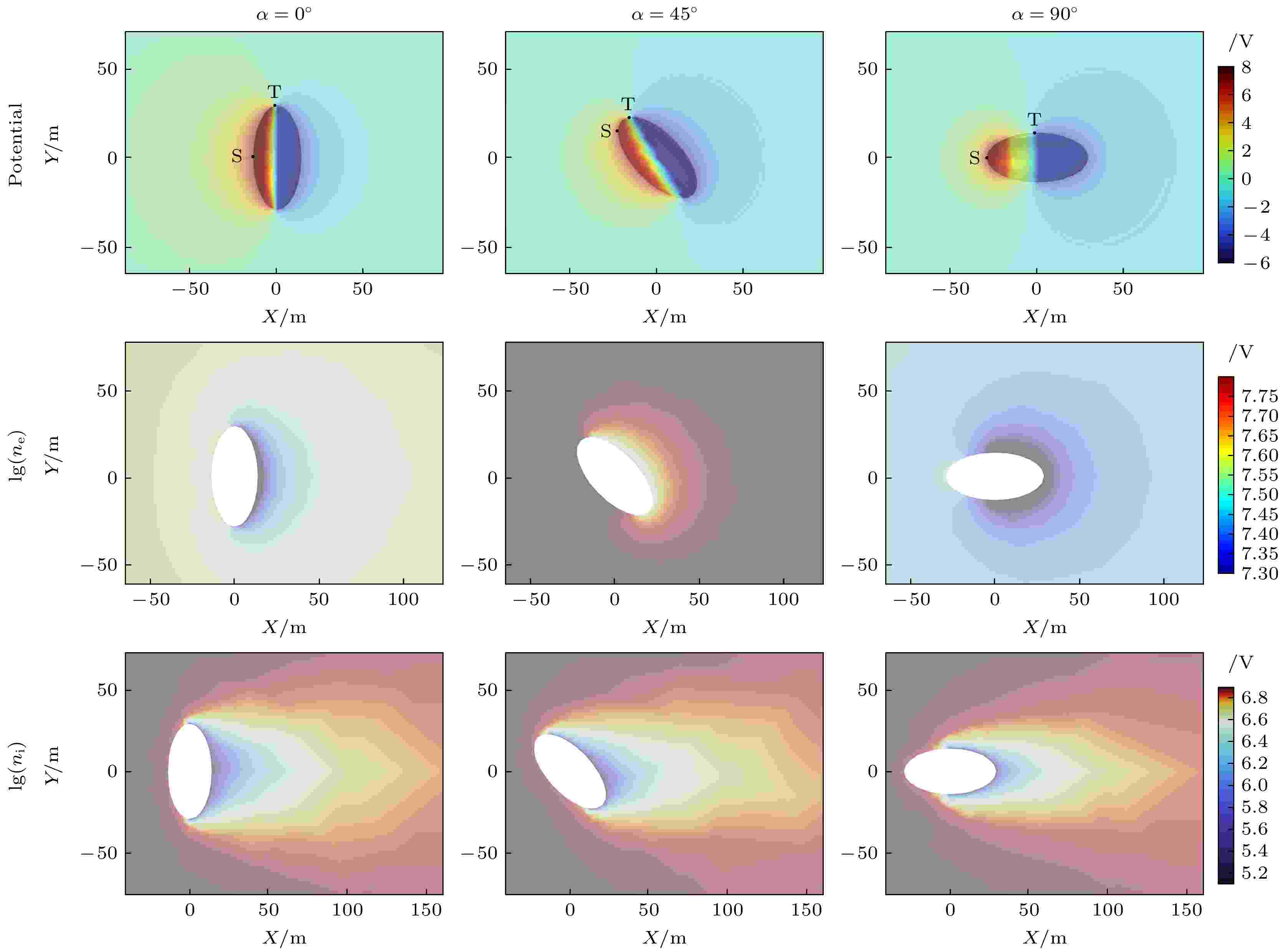
2024, 73 (24): 249601.
doi: 10.7498/aps.73.20241182
Abstract +
The attachment and movement of charged particles in the space plasma environment can result in observable potentials on the asteroid surface. This surface charging phenomenon has been extensively studied. However, so far, the influence of asteroid rotation on surface charging and the surrounding plasma has not yet been fully understood. Traditional methods using numerical integration and PIC have slow computation speeds, and mainly focus on the charging mechanisms of static asteroids. In this study, we establish a multi-scale model based on neural networks and the finite element method, thereby improving simulation efficiency and enabling three-dimensional dynamic simulations of rotating asteroids. Simulation results for asteroids with different rotation periods indicate that both the maximum surface potential and the minimum surface potential decrease as the rotation period increases. The minimum potential on the nightside decreases from –4.96 V with one-hour period to –5.97 V with one-week period. For asteroids with longer periods, this downward trend slows down: the period increases from one week to half a year, resulting in a potential change of 0.001 V. Because strong electric field near the the terminator accelerates electrons and ions, electrons respond more promptly to the electric field, owing to their much higher mobility and diffusion coefficient, exhibiting a more severe accumulation phenomenon than ions, resulting in the decrease of the surface potential. This phenomenon is most pronounced when the solar wind is obliquely incident, where the subsolar point is close to the terminator, resulting in the strongest electric field. When the period exceeds one week, this downward trend becomes less pronounced, specifically, the asteroid and plasma have enough time to reach equilibrium at various angles. During the passage of solar storms, there is a significant change in surface potential at different stages, with potential difference caused by rotation periods reaching hundreds of volts. Surface minerals also play a role, with plagioclase being the most sensitive mineral in the exploration, while ilmenite seems indifferent to changes in rotation periods. Understanding the surface charging of asteroids under various rotation periods and angles is crucial for further studying the solar wind plasma and the motion of asteroid’s surface dust, providing a reference for achieving safe landing and exploration of asteroids.







